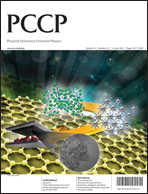Fixed node diffusion Monte Carlo using a genetic algorithm: a study of the CO–4HeN complex, N = 1…10
Abstract
The diffusion Monte Carlo (DMC) method is a widely used algorithm for computing both ground and excited states of many-particle systems; for states without nodes the algorithm is numerically exact. In the presence of nodes approximations must be introduced, for example, the fixed-node approximation. Recently we have developed a genetic algorithm (GA) based approach which allows the computation of nodal surfaces on-the-fly [Ramilowski and Farrelly, Phys. Chem. Chem. Phys., 2010, 12, 12450]. Here GA-DMC is applied to the computation of rovibrational states of CO–4HeN complexes with N ≤ 10. These complexes have been the subject of recent high resolution microwave and millimeter-wave studies which traced the onset of microscopic superfluidity in a doped 4He droplet, one atom at a time, up to N = 10 [Surin et al., Phys. Rev. Lett., 2008, 101, 233401; Raston et al., Phys. Chem. Chem. Phys., 2010, 12, 8260]. The frequencies of the a-type (microwave) series, which correlate with end-over-end rotation in the CO–4He dimer, decrease from N = 1 to 3 and then smoothly increase. This signifies the transition from a molecular complex to a quantum solvated system. The frequencies of the b-type (millimeter-wave) series, which evolves from free rotation of the rigid CO molecule, initially increase from N = 0 to N ∼ 6 before starting to decrease with increasing N. An interesting feature of the b-type series, originally observed in the high resolution infra-red (


 Please wait while we load your content...
Please wait while we load your content...